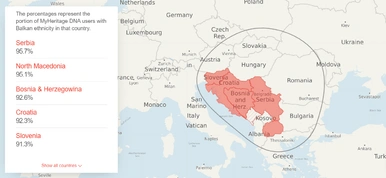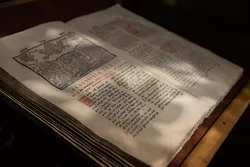
Balkan ethnicity indicates genetic origins in the Balkan Peninsula of Southeastern Europe, encompassing modern-day Albania, Bosnia and Herzegovina, Bulgaria, Croatia, Kosovo, Montenegro, North Macedonia, Romania, Serbia, and Slovenia. The peninsula houses a rich mosaic of ethnicities, comprising Albanian, Slavic, Vlach, Italo-Roman, Celtic, and Germanic origins. Diverse heritage, coupled with devotional heterogeneity — including Catholicism, Orthodox Christianity, Islam, and Judaism — has unfortunately resulted in bloody internal conflicts. As a consequence of either voluntary departure, coerced and/or forced migrations, or expulsions that occurred on several occasions over a period spanning a century and a half, the Balkan diasporas are quite substantial, including communities in neighboring Balkan countries, Europe, the Americas, and Australia.
Research your ancestors on MyHeritage
Balkan historyBalkan history

The Balkan peninsula’s oldest recorded civilizations — the Thracians and Illyrians — were challenged and ultimately subdued by the Roman armies before the turn of the Common Era. In 395 C.E., the Roman Empire was split in two with the dividing line running through the Balkans: a schism which drove an enduring fissure into the peninsula. Germanic tribes invaded in the 5th century, followed a century later by Slavic tribes, including Slovenes, Croats, and Serbs, as well as Turkic Bulgars (who later adopted Slavic culture). The irrevocable split between Rome and Constantinople in 1054 cemented the divisions between Catholic (Croats and Slovenes) and Eastern Orthodox (Serbs, Bulgarians, and Romanians) residents of the peninsula.
Starting in the 11th century, the Kingdom of Hungary subsumed the lands of the Croats and Bosniaks, and the region of Transylvania. The Ottoman capture of Adrianople (Edirne) in 1362 signaled the beginning of Muslim presence in the Balkans. The Ottomans pushed out the Hungarians and conquered the peninsula, reaching as far as the gates of Vienna in Central Europe, sparking a complete social and political restructuring of the region. By the late 17th century, Ottoman decline enabled the Habsburg monarchy to assert itself in large parts of the peninsula.
The 19th century saw the rise of nationalism in the Balkans coincide with the weakening of Ottoman power, a process which resulted in the establishment of an independent Greece, Serbia, and Bulgaria. The Balkan Wars (1912–13) and subsequent retreat of Ottoman forces from the peninsula precipitated the persecution of Muslims, including Albanians, Bosniaks, Serbs, and others. After World War I, a unified Kingdom of Serbs, Croats, and Slovenes was established, which in 1929 was renamed Yugoslavia (“Land of the Southern Slavs”). Following World War II, a second, communist Yugoslavia was formed by Josip Broz Tito and his communist-led Partisans who had liberated the country from German rule in 1944–45. Tito, who successfully managed to stave off the Soviet yoke, held Yugoslavia together for 35 years despite its underlying ethnic and religious tensions.

Following Tito’s death in 1980, simmering tensions resurfaced. In a series of related but separate ethnic conflicts, wars of independence, and insurgencies fought between 1991 and 2001, Yugoslavia was rocked by devastating genocides and ethnic cleansings, resulting in the death of 140,000 people. Most of the conflicts ended through peace accords, resulting in full international recognition of the new states. In 2003, what remained of Yugoslavia was officially renamed Serbia and Montenegro. A referendum held in 2006 led to an independent Montenegro; in 2008, Kosovo declared its independence from Serbia.
Balkan cultureBalkan culture

Like its demography, the Balkan region is culturally diverse. It was and continues to be a bridge between rich cultures and identities: Balkan music, incorporating Slavic and West Asian influences, distinguished by its rhythmic energy, has gained international popularity in recent years. Balkan cuisine strikes a balance between East and West, including Turkish, Greek, Italian, Central European, and Mediterranean influences. Regional specialties include ćevapi (a grilled dish of minced meat, similar to kebab), börek (baked, filled pastries made of a thin flaky dough), and pljeskavica (a grilled, spiced meat patty mixture of pork, beef, and lamb), among others.
Balkan films and filmmakers have made a splash on the international scene, harking back to the 1960s and the Zagreb-based “Black Wave” movement. Most notable among Balkan filmmakers is Serbian director Emir Kusturica, whose film Underground — which portrays the history of Yugoslavia from the bombing of Belgrade by the Germans in 1941 to the terminal rupture of the Yugoslav federation — won the prestigious Palme d'Or prize at the Cannes Film Festival in 1995.
Textile production is an important part of Balkan cultural history. Traditionally, folk costumes denoted family history, social status, and origin. The Ottoman influence is apparent in the use of coins in headdresses, necklaces, and belts from various regions, including Bosnia, Serbia, Macedonia, and Montenegro. Traditional craft products are regarded as cultural heritage in the Balkans, with ongoing efforts made to preserve folk knowledge and technologies in the face of mass production and an increasingly globalized economy.
Balkan languagesBalkan languages

While Albanians and Kosovars speak Albanian — an Indo-European language of unknown origins — and Romanians speak Romanian — a Balkan Romance language derived from Vulgar Latin — Slavic languages predominate in the Balkans: Bulgarians, North Macedonians, and Slovenes speak their own Slavic languages, while the residents of Serbia, Croatia, Bosnia and Herzegovina, and Montenegro all speak dialects of Serbo-Croatian.
See alsoSee also
Explore more about ethnicity estimatesExplore more about ethnicity estimates
- MyHeritage DNA
- Ethnicities around the world at MyHeritage
- What Is My Ethnicity? How MyHeritage Estimates Ethnicities at MyHeritage Knowledge Base
- Where's My Ethnicity?!: Why An Ethnicity Might Not Show Up In Your DNA (and How To Find Evidence Of It Anyway) at MyHeritage Knowledge Base

